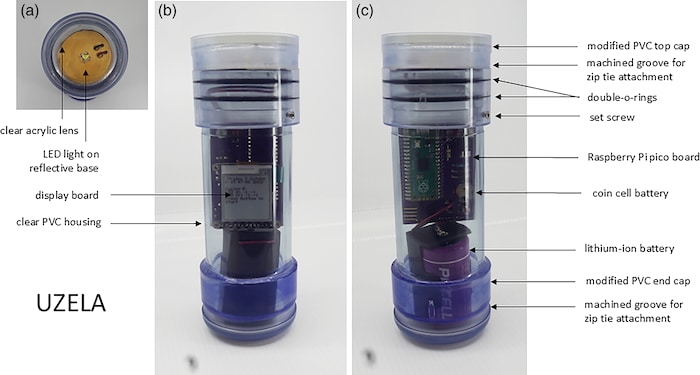This post was originally published on Eco Watch
Scientists at The Ohio State University have developed a new device known as Underwater Zooplankton Enhancement Light Array (UZELA), which will help promote more feeding sources for coral restoration.
UZELA is a submersible, programmable light that can be deployed at a site for up to six months on one battery. If the devices need any maintenance, trained divers can easily handle this. UZELA turns on for about one hour per night, and the emitted light helps increase concentrations of zooplankton while minimizing artificial light disruption to other marine species. This allows corals more feeding opportunities, according to the scientists.
The team tested the device near two native corals in Hawaii, Montipora capitata and Porites compressa. After running the UZELA, the amount of locally concentrated zooplankton increased seven-fold, while the coral feeding rates increased between 10- and 50-fold. The scientists published their findings in the journal Limnology and Oceanography: Methods.
“Coral reefs house one-third of all marine species, yet occupy less than 1% of the ocean,” Andréa Grottoli, lead author of the study and earth sciences professor at The Ohio State University, said in a statement. “They are disproportionately responsible for ocean health and we’re at risk of losing them.”
Coral reefs are threatened by extreme heat stress. Last year, the U.S. National Oceanic and Atmospheric Administration (NOAA) warned that the world was experiencing its fourth mass coral bleaching event, which is when the corals lose symbiotic algae that provide nutrients to the corals because of extreme heat. From February 2023 to April 2024, NOAA found that about 60.5% of global corals had experienced bleaching.
Bleaching can make coral more vulnerable to disease and die-off, and water temperature and conditions must return to normal for algae to return to coral. However, by concentrating zooplankton near coral, they can feed and obtain nutrients to help their road to recovery.
With such great threats facing coral reefs, the study authors noted that UZELA is only one temporary solution to the plight of reef systems. For now, it could work in some of the most vulnerable and important reef systems to boost restoration efforts until more substantial actions are taken to minimize stressors that trigger bleaching.
Labeled (a) top view of lens cap (7cm diameter) and (b) and (c) side view (20cm tall) photographs of UZELA (Underwater Zooplankton Enhancement Light Array) (Grottoli, Jackson, and Steck 2023, PCT/US2023/078357). Photos by AM Hulver
“Think of it as a band-aid for about a couple decades,” Grottoli said. “It can protect some corals in some places, sometimes.”
Currently the UZELA devices are made by hand, but the scientists are collaborating with a local engineering company to redesign UZELA for scalability. The updated device could be ready within one to three years, according to Grottoli.
“We are not mitigating climate change fast enough to save coral, and UZELA is not going to instantly save coral reefs,” Grottoli said. “But it is an exciting solution that will buy us time as we work toward a more sustainable environment.”
First paper ever alert! We found that locally increasing zooplankton using the Underwater Zooplankton Enhancement Light Array (UZELA) can increase feeding in two Hawaiian coral species up to tenfold. aslopubs.onlinelibrary.wiley.com/doi/10.1002/…
— Shannon Dixon (@shannon-dixon.bsky.social) February 6, 2025 at 3:15 PM
The post Scientists Develop a Feeding Tool for Coral Reef Restoration appeared first on EcoWatch.





0 Comments